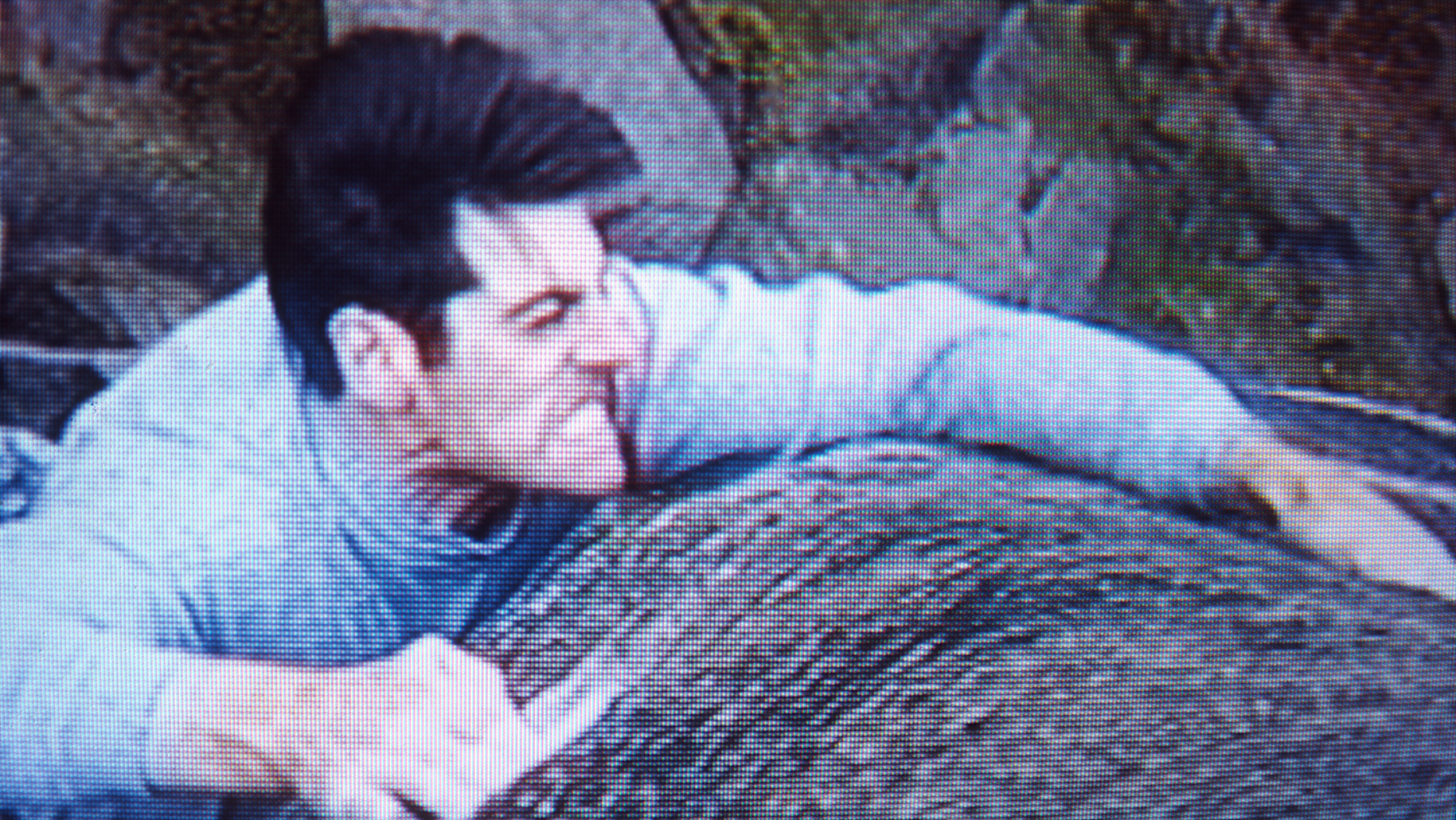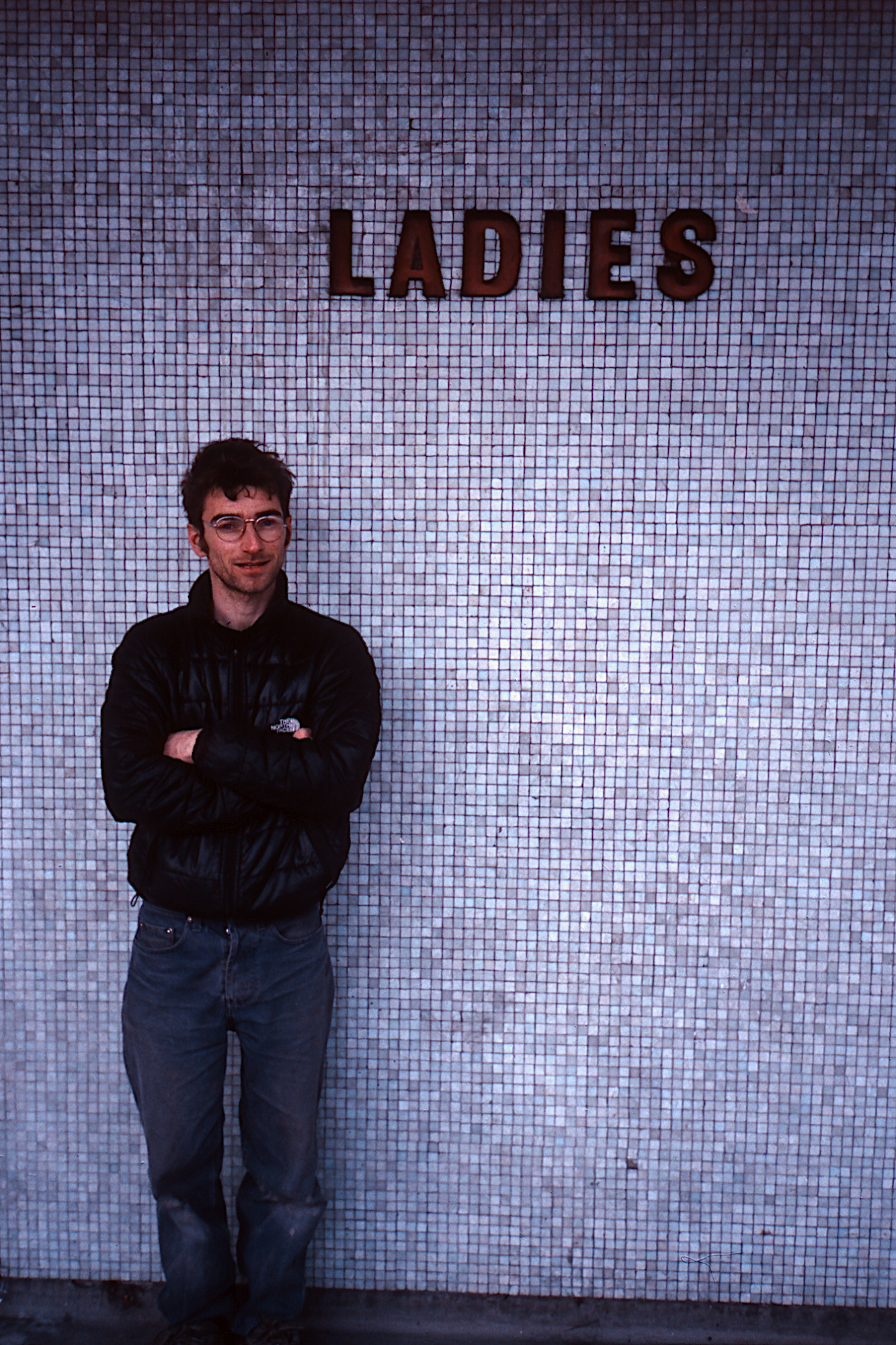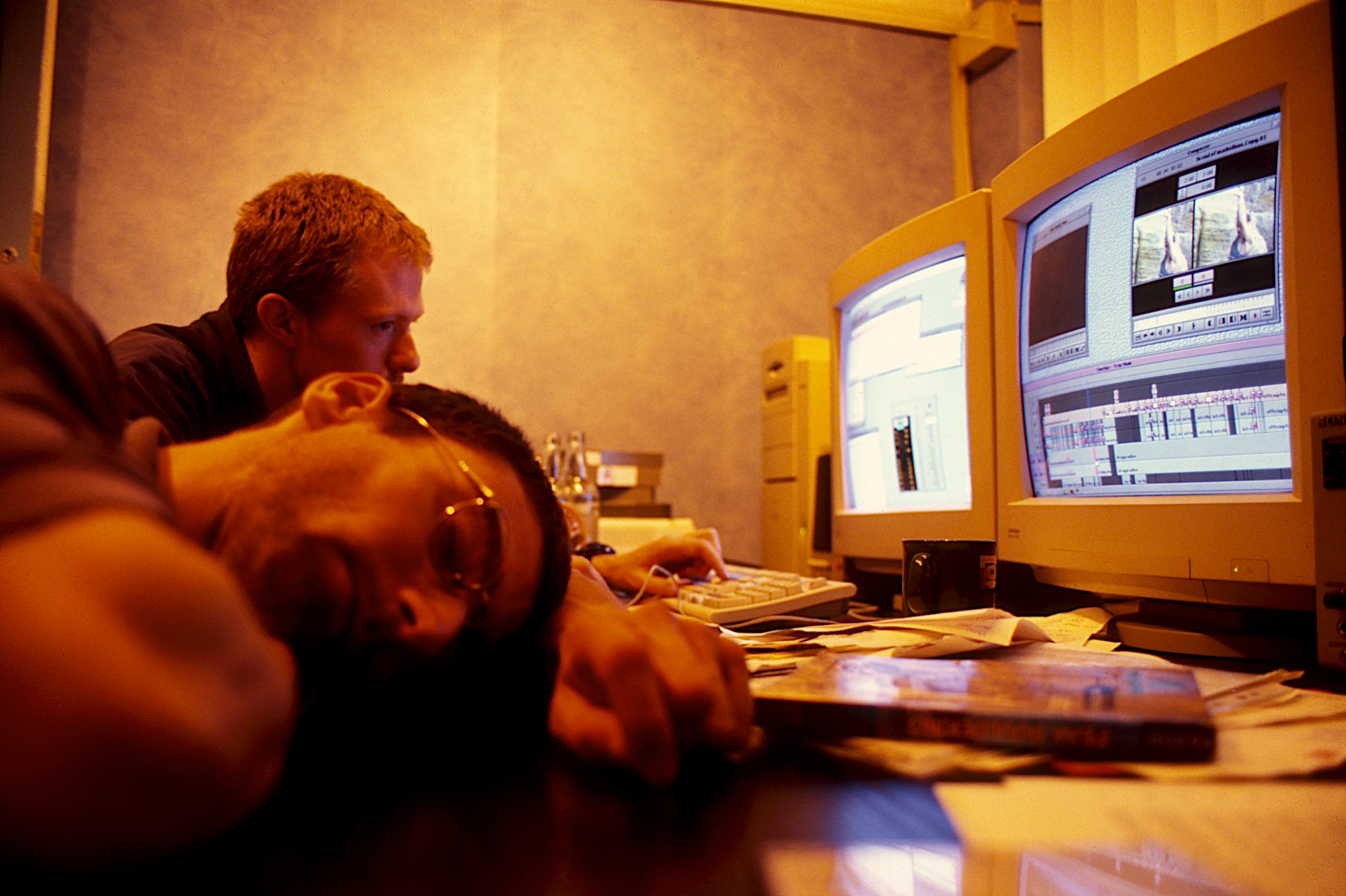Hard Grit: Twenty Years On

Rich Heap (right) and Mark Turnbull. Photo: Seb Grieve
In 1998, filmmakers Mark Turnbull and Rich Heap released a movie that changed climbing. The film, Hard Grit, shone a light on the hard gritstone traditional climbing of the UK's Peak District. The opening sequence of Jean-minh Trin-Thieu falling from Johnny Dawes classic route Gaia captured viewers' attention and they were taken on a journey through some of the country's most dangerous gritstone routes and hard bouldering. Released in 1998, Hard Grit not only spurred a generation to push themselves harder on the gritstone edges of the UK but created a league of new British climbing filmmakers. The film also launched the filmmaking career of Rich Heap, and here, nearly two decades after its release, he reflects on the film's impact on climbing and his life.
All images contemporary to the film kindly supplied by Rich Heap as original 35mm slides.
The Making Of
In a funny sort of way Hard Grit found me. It was no more than an extension of what I was doing in my climbing life. Nowadays people film their mates bouldering as a matter of course and in simple terms the origins of Hard Grit were the same: Me filming my mates. Obviously back then it was a slightly more conscious thing, as it wasn't normal practice and I had to have a camera! I didn't even have a laptop or mobile phone at the time.
By early 1997 I had been on the dole (benefits) for a couple of years, climbing full time. I was pretty immersed in the Sheffield scene, hanging out with people like Neil Bentley, Nic Sellers, Jon Barton, Malc Smith, Gav Ellis etc. There would often be a dozen of us head to Buoux for two months. I also rented a room in Seb's house and would later live on the same street as Johnny Dawes.
After about two years on the dole I started doing a video production course at a local college, one day a week so I didn't feel a complete waster. As a consequence of that Johnny asked me to help finish editing Best Forgotten Art (the Ray's Roof sequence still has to be one of the maddest—and greatest—bits of any climbing vid). Then he went off to the States and left me with his camera. When Neil went out to do Renegade Master I took the camera. Filming him seemed a better option than catching him! I'd leave that to Andy Harris.
When Autumn came Seb started on Parthian and I was going out belaying him. When he came to lead it I was naturally part of the crew and took the camera for that. Because I¹d been around a lot of hard grit ascents before, I knew what the atmosphere was like and almost how to act with the camera. The art was to blend in to the background, not project what I was doing on to the day out, to be relaxed and I think that comes across.
Things just moved on from there and slowly over a season I went from having bits of climbing footage to the basis of what might be an exciting film.
“There was one day after which I knew we had something really special... we left the crag shell-shocked but knowing we had something potentially awesome”
In many respects Hard Grit is a bit staid and boring, except for the access, the action. I think straight afterwards I had a reaction to it, so for things like Stick It, Stone Love, Dragon's Back Race and HardXs (which I made with Ben Pritchard) I wanted to get away from voice over, a conventional TV-ish type feel. I think these later films feel more organic, reflecting mine and Ben's personalities more.
That said, I had to watch Hard Grit before the Ape Index night just to remind myself of it. I was surprised how strong the writing in it was and how coherent a piece it was, driving from the past and in to the future. The tension is also a lot stronger than I remember and at the Ape Index night seeing Leo's ascent on the big screen was really thrilling, getting a round of applause. The editing is also very, very crisp. Seb's two days and six tries on Parthian distilled down to 7/8 minutes.
There was one day after which I knew we had something really special. On the same day we (I was working with Mark Turnbull by now) filmed both Seb's ascent of Meshuga and Jean-Minh falling off Gaia. It had been a struggle to get to the crag as I was working but with that rush and the intensity of the ascents, we left the crag shell-shocked but knowing we had something potentially awesome. I also started to realise how generous the climbers were in letting us film (intrude) and with that came a responsibility to do the material justice.
After this I started to want to find a structure for the film and make it definitive. That's when we started to think about the history section, future routes and making sure we got most of the main protagonists, Leo, Johnny, Jerry, Jon Dunne, Sam Whittaker, etc.
There is also a very slim narrative about the different aspects of grit climbing—the line, the power, the danger, the mind games—running through the film. This was conscious and we structured the edit around it.
However, I believe the thing that makes Hard Grit special was not of my making, or at least it was accidental. That window on to ascents that had hitherto been private, the events small time affairs. I just happened to find myself in the midst of it with a camera, pointing and shooting. It wasn't much more than that. tTen having experienced the palpable heart-stopping tension of the days out, the art was to re-create the feel in the edit, choosing the right music. I guess that's why you just have to get out there and do it, start working, filming, because you often don't know what you have until later.
The Narrative
Hard Grit was really a random collection of routes but when I sat down to think about the editing I had to impose a structure out of necessity. If you don’t know where you are heading you can get a bit swamped by the scale of the task and the amount of material you have. I think you also have to be a bit more confident to make something without the straitjacket of narrative, rely on tone, feel.
As I’ve said, since Hard Grit I’ve shied away from voice over but it is an easy way to instil structure and maybe that’s why modern films, particularly bouldering films, don’t feel as though they have much narrative. But what they do have is mood and that’s not such a bad thing! Also generally things are shorter now, so you can get away with less depth. I think once something is over eight to 10 minutes you begin to feel any lack of true content. Until then pretty pictures can do the trick. A narrative film naturally stems from an interest in investigating something. If you are investigating something, you, as a filmmaker, are going on a journey and then it is easy to take a viewer with you. The journey becomes the narrative. Even with something as random as HardXS I felt like I was looking at “process” and we look that magnifying glass to the broad spectrum of British climbing.
Johnny Dawes at Millstone Edge. Photo: Rich Heap
Personal Career
Making Hard Grit obviously had a huge impact on my career. Before it I wasn’t a filmmaker. After it I was. We got a commission off of the BMC to make a hillwalking skills film after it and we also got enough money to buy a camera. We met another local film maker Eve Wood and helped her make a film about the Sheffield music scene in the 80s and it also opened up a dialogue with Simon Wells of Chameleon TV. He had done a lot of adventure films and had a commission from Channel 4 to do a series of video diaries. I pitched doing the Salathe to him and this morphed in to Blood, Sweat and Bagels. So yes, Hard Grit was like an awesome shop window and it had enough reach that people I didn’t know said hello!
The Impact
Hard Grit inspired a new generation to test themselves on the edges of the Pennines. Four of those who followed in the footsteps of those in the film, and pushed gritstone climbing even further, reflect on its impact.
David Mason
What springs to mind when I think of UK climbing? Two things that are at quite opposite ends of the spectrum. The first is training: High impact, tendon screaming training. Pulling on tiny pieces of wood in dingy, damp cellars. This is hard wood. The second is subtle, delicate movement in precarious situations where a wrongly weighted foot can have atrocious consequences. This is hard grit. My climbing apprenticeship didn’t start especially young, it didn’t start on gritstone and it certainly didn’t start with trad climbing. Yet I have watched Hard Grit more times than I care to remember. From incredible rock features and intricate movement in death defying situations to classic quotes, teeth gritting try-hard and supportive friends having fun doing what they love, this film epitomizes what climbing means to me. It’s the full package and it’s riveting in its entirety, culminating in Seb talking his way up the Promontory Project at Black Rocks. Yes, it inspires me to try these classic gritstone test pieces but it’s so much more than that. It’s what I feel climbing is all about encapsulated in an hour of, edge of the seat, heart thumping pleasure.
Kevin Jorgeson
In addition to a beautiful line, there are two factors that really attract me to a climb: Something new, or something historical. Without Hard Grit I doubt there would have been a UK trip in 2008. The film did a great job of telling the backstory of these historical first ascents. They became surrounded by lore and mystery. Being 25, ambitious, and willing to take risk, I really wanted to test myself on these historical lines. I knew I wanted to try Gaia, Parthian Shot, Meshuga, End of the Affair, The Groove, The Promise, and others. I must say, the grit delivered everything I was hoping for out of the experience and much, much more. This remains one of my most memorable trips to date.
Katy Whittaker sending Gaia E8 6C. Photo David Mason
Katy Whittaker
I remember first getting Hard Grit on VHS when I was a kid. My brother and I watched it many times over the next few years. On first watching it I never considered I would climb any of these routes, but one thing in particular stood out to me and remained etched on the back of my skull. That gripping heart beat sound and terrifying scream; it had my hands sweating and toes curling but I couldn’t get over how incredibly beautiful and perfect the climb was (Gaia E8 6c at Black Rocks). It took me another 10 years before I plucked up the courage to lead it. It is quite odd to think back that as a young girl this bunch of completely crazy climbers were my heroes, with their quotes repeated and mimicked as I found similar moves and this iconic list of routes hunted out so I could witness them in the flesh. I’d never seen people try such hard and dangerous climbs before and it was my gate way into hard grit.
Ned Feehally
1997. I'd just started climbing at my local wall as a small child. I remember someone told me I should watch "True Grit"—a film about people going climbing. He was pretty enthusiastic, and I can actually remember him saying “even the easy bit is 6b” referring to some route or other. It sounded exciting, and at the time I couldn’t comprehend such difficulty. I forgot about that recommendation (I can't think why) but a few years later I ended up accidentally watching a film called Hard Grit. Most of it went over my head. To be honest the bit that struck me the most is when Seb is discussing Parthian Shot while a fly crawls across his face. I couldn't understand why he didn't notice it. He must have been deeply in the zone or something.
While I didn't get a lot out of the film at the time, it did introduce my to a world of climbing outside of the small climbing wall that I was used to. I knew that rock climbing and gritstone was something that I wanted to see for myself. Over the years I kept referring back to the film. My experiences of going climbing on gritstone started, in their own little way, to line up with what I remember seeing in Hard Grit. The excitement, the wobbles and the camaraderie. It felt like in some small way I was becoming part of the club. Eventually, 10 years after my first viewing I found myself living in Sheffield, getting to try some of the routes and boulders myself and even managing to climb up a couple of them. Headpointing was never something I understood or got into, but the idea of scaring yourself silly on a short rock climb still appealed to me. As the fashion for headpointing faded away it left space for piles of bouldering mats and spicy ground up ascents. The more modern approach definitely altered the challenge, but it hasn’t taken much away from the experience.
20 years on and it still feels relevant. Hard Grit is still happening. We may have brighter trousers, fewer dreadlocks and more bouldering mats but the scene is still strong. The routes still offer a place to to feel very lonely just a few meters from the ground. Gritstone is somehow still more than the sum of it’s parts. Heroes can still be punters, and punters can still be heroes.
Download Hard Grit here.
Editor












